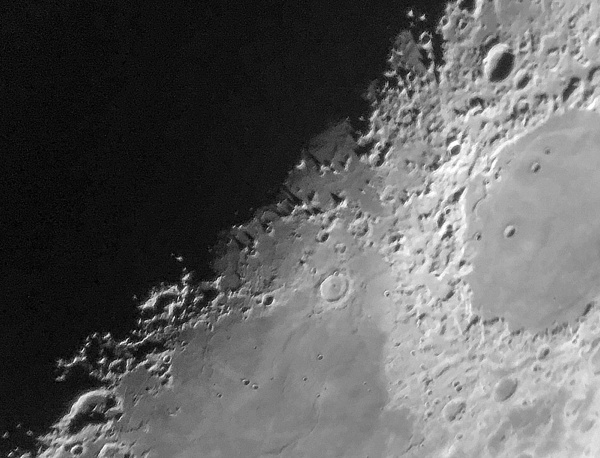iPhone Moon Imaging;
StarLock (getting better); DSLR imaging NGC2841, M13
Posted: 11 May 2016
|
Open: Tuesday, 10 May 2016, 1832 MST Temperature: 88°F |
Session: 960 Conditions: Clear, breezy |
Equipment Used:
12" f/8 LX600 w/StarLock
Wireless AutoStar II handset
2" OPT diagonal
2" 24mm UWA eyepiece
1.25" 40mm eyepiece
1.25" 26mm eyepiece
2" 2X PowerMate
Camera:
iPhone 6s Plus
D7200 DSLR
1838 MST: LX600 ON, StarLock OFF. Viewed the Moon, 102X. Switched to the 1.25" 40mm eyepiece (61X). Good view of the Moon.
Took this handheld iPhone 6s Plus photo of the Moon, afocal 61X:

1917 MST: sunset. Calm now.
Switched to the 1.25" 26mm eyepiece + 2X PowerMate. Some nice views along the terminator at 188X. Using the SteadyPix Universal Smartphone Telescope Photo Mount to hold the iPhone, took these afocal 188X photos (cropped):


1950 MST: did some quick lunar observing, 203X. Then viewed Jupiter, 203X. The four Galilean Moons were visible.
1955 MST: began preparing for this night's tests of StarLock autoguiding. Mounted the DSLR at prime focus of the 12" telescope. Did a collimation test image on the star Procyon, which was good, followed by a focus test with the Bahtinov Mask using the star Capella. SYNCed the AutoStar on Capella.
StarLock ON and did a GOTO NGC2841 (galaxy). Nothing was visible in the DSLR viewfinder, but then the galaxy was faint. Did a 1 minute exposure; no galaxy. Did a GOTO using the RA/DEC for NGC2841 and repeated the exposure, but again no galaxy. As it turned out, StarLock pointing was about 2° in error, confirmed by doing a GOTO the star Castor, which was not centered. StarLock OFF and did a GOTO Caster; centered. Apparently the bright moonlight was interferring with the StarLock wide field camera to do "star matching". With the StarLock OFF did a GOTO NGC2841 and did a test image; got it. StarLock ON (for autoguiding tests). Did 1 minute exposures, ISO 6400, White Balance 4000K at StarLock guiding rates (both RA and DEC) of 10%, 50%, 66%, and 75%. All tracked good. Then did 4 minute exposures at 10% and 75%. There wasn't much difference in the two images. This is the 4 minute exposure using guiding rates of 10%, slightly cropped:

The above image is in black-and-white due to the bright moonlight, which brightened the background sky.
Will do more StarLock tests once the Moon is no longer interferring, but I think I'm learning how to use the StarLock for autoguiding. Will be trying longer exposures on fainter objects on future sessions.
Turned the StarLock OFF and did a GOTO M13 (Great Globular Cluster in Hercules) and did some test exposures. This is a 20 second, ISO 6400, WB 4000K, image, slightly cropped:

2123 MST: done with imaging for the night. Took a quick look at M13, 102X. Then began closing up. A long day of activities was planned for the next day.
|
Close: Tuesday, 10 May 2016, 2141 MST Temperature: 66°F |
Session Length: 3h 09m Conditions: Clear |
Comments are welcome using Email. Twitter users can use the button below to tweet this report to your followers. Thanks.
Cassiopeia Observatory Home Page
Copyright ©2016 Michael L. Weasner / mweasner@me.com
URL = http://www.weasner.com/co/Reports/2016/05/11/index.html
